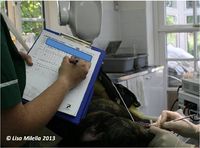Difference between revisions of "Oral Examination Under General Anaesthesia"
Ggaitskell (talk | contribs) |
|||
| Line 88: | Line 88: | ||
[[Category:Oral Examination]] | [[Category:Oral Examination]] | ||
| − | [[Category:To Do - | + | [[Category:To Do - Mars Check]] |
Revision as of 11:52, 13 September 2013
Introduction
The endotracheal tube does not allow full closure of the mouth to examine the relationship between the teeth. In the anaesthetised patient prior to intubation, the muscles are relaxed and the tongue often gets in the way, so a complete evaluation of occlusion is not always possible.
The oropharynx should be examined prior to endotracheal intubation. Normal anatomical features of the oral cavity need to be identified and inspected. A check list is given below:
|
|
|
|
|

Any abnormalities need to be noted – look for swellings, inflammation, ulcerations. Check if the lesion is localised to one area or more generalised. Always biopsy abnormal tissue if a cause cannot be identified.
Under general anaesthesia, it is also useful to recheck the temporomandibular joints for crepitus or clicks if a problem is suspected. The mandibular symphysis should also be checked for mobility – a small degree of movement is normal in cats.
Indices and Criteria
The following indices and criteria should be evaluated for each tooth:
- Gingivitis and gingival index
- Periodontal probing depth
- Gingival recession
- Furcation involvement
- Mobility
| This article has been peer reviewed but is awaiting expert review. If you would like to help with this, please see more information about expert reviewing. |